If there’s one thing I learned about Detroit last weekend, it’s that it is freaking huge. It’s an unbelievably large city, and looking at the population numbers, you can really start to see the problem of providing city services to such a large area. With such a sparse population, it’s the ideal environment for experimentations in urban farming, after a few seasons of planting crops that will leech everything out of the soil of course.
If you have a farm, you’re going to need some means of irrigation, and you might as well throw a scarecrow in there as well, giving i3 Detroit the idea for RoboCrop, the perfect project for an urban farm or anyone who is putting on a production of The Wizard Of Oz but is a little shorthanded for a full cast.
RoboCrop is an all-in-one irrigation and bird and small mammal scaring device, controllable with webcam video streamed right to the remote. It’s a fun project, and fits right into the apparent unofficial “urban gardening” theme of this year’s Red Bull Creation.
i3 is also the largest and arguably the best equipped hackerspace in the Detroit region. They were kind enough to let us throw a little get together there last weekend where we gave away a 3D printer for The Hackaday Prize. Good times all around. We’ll have a video tour of i3 up a little bit later.






 With few exceptions, most of The Hackaday Prize are things we really haven’t seen much of before: base-3 computers that have been relegated to the history books, extremely odd 3D printers, and fancy, new IoT devices are the norm.
With few exceptions, most of The Hackaday Prize are things we really haven’t seen much of before: base-3 computers that have been relegated to the history books, extremely odd 3D printers, and fancy, new IoT devices are the norm.  Before this project, [David]’s office had a fairly terrible system to tell everyone who was in the office, who was out, and who wasn’t coming in today. Velcro and whiteboards will do the job, but arcade buttons and LEDs called to [David], leading him to create this
Before this project, [David]’s office had a fairly terrible system to tell everyone who was in the office, who was out, and who wasn’t coming in today. Velcro and whiteboards will do the job, but arcade buttons and LEDs called to [David], leading him to create this 

 There’s a problem with products geared towards building the Internet of Things. Everyone building hardware needs investors, and thus some way to monetize their platform. This means all your data is pushed to ‘the cloud’, i.e. a server you don’t own. This is obviously not ideal for the Hackaday crowd. Yes, IoT can be done with a few cheap radios and a hacked router, but then you don’t get all the cool features of a real Things project – mesh networking and a well designed network.
There’s a problem with products geared towards building the Internet of Things. Everyone building hardware needs investors, and thus some way to monetize their platform. This means all your data is pushed to ‘the cloud’, i.e. a server you don’t own. This is obviously not ideal for the Hackaday crowd. Yes, IoT can be done with a few cheap radios and a hacked router, but then you don’t get all the cool features of a real Things project – mesh networking and a well designed network. 









